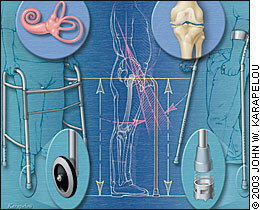
Am Fam Physician. 2003;67(8):1658

We will soon publish some reading that you may want to add to your “must do”list—watch for an upcoming update on bioterrorism in the May 1 issue of AFP. This article reviews the six biologic disease agents considered of highest priority by the Working Group on Civilian Biodefense: anthrax, smallpox, plague, turalemia, botulism and viral hemorrhagic fevers. The authors of the article are Karen K. O'Brien, LTC, MC, USA, Mark L. Higdon, MAJ, MC, USA, and Jaime J. Halverson, CPT, MC, USA, Martin Army Community Hospital, Fort Benning, Ga.
The article offers diagnosis, treatment, and response strategies for the six biologic agents that pose the highest threat. These agents are most likely to be used in a bioterrorism attack because of the ease of dissemination or transmission, their potential to cause widespread panic, and the resource-consuming government responses that are required to investigate and manage an attack.
The article provides a number of resources, including summary tables showing prevention, diagnosis, and treatment, and use of vaccines and antibiotics in women who are pregnant or breastfeeding. The article also includes a table listing online resources, including the American Academy of Family Physicians bioterrorism Web page atwww.aafp.org/btresponse.xml and the Centers for Disease Control and Prevention (CDC) page atwww.bt.cdc.gov.
The May 1 article will be accompanied by an editorial on bioterrorism preparedness for family physicians, written by Helga E. Rippen, M.D., Ph.D., RAND Science and Technology Policy Institute, Arlington, Va., Elin Gurskey, Sc.D., ANSER Institute for Homeland Security, Arlington, Va., and Michael Stoto, Ph.D., RAND Science and Technology Policy Institute. The authors point out that family physicians and other primary care clinicians have a critical responsibility to the community in terms of prevention, detection, treatment, and education before, during, and after a terrorist event. Family physicians must cooperate with local health departments to ensure proper medical response to such outbreaks. The authors provide a list of responsibilities for family physicians responding to such cases, including contacting local and state health departments immediately when they encounter suspicious cases (www.statepublichealth.org).
In this issue of AFP, you will find a summary of CDC guidelines for diagnosing and treating adverse reactions to smallpox vaccination in the preoutbreak setting.(See “Practice Guidelines” on page1827.) The guidelines are also available atwww.cdc.gov/mmwr/preview/mmwrhtml/rr5204a1.htm.
For convenient access to timely topics, you might want to keep in mind that AFP's articles are available online a few days before the printed issues hit the mail stream. You will find the bioterrorism update atwww.aafp.org/afp in the first week of May.
You may find it helpful to preview AFP's bimonthly offerings of topics by receiving the table of contents via e-mail. AFP's e-mail table of contents will alert you when issues are made available online and also provide convenient links to articles and departments. To receive AFP's table of contents via e-mail, all you need to do is click on the e-mail table of contents logo atwww.aafp.org/afp and provide your e-mail address.